A Novel Sound Coding Strategy for Cochlear Implants Based on Spectral Feature and Temporal Event Extraction
Abstract
1. Introduction
- A flexible frequency allocation that allows advanced FAM fitting methods to adopt anatomically inspired approaches to optimize hearing performance. Furthermore, as technology evolves, this feature can meet the needs of electrode arrays with higher numbers of contacts, requiring precise and narrow low-frequency bandwidths.
- A more precise extraction of spectral features for electrical stimulation, minimizing the spectral blurring effect, ensuring that signals with narrow-band harmonics stimulate only the relevant electrode as defined in the clinical FAM.
- A method to measure the similarity between the frequency content of the analyzed signal and that of a sinusoid signal at a given frequency, using a metric of spectral sharpness, enabling the encoding of spectral features more efficiently.
2. Materials and Methods
2.1. Spectral Feature Extraction (SFE) Strategy
2.1.1. Synthetic Feature eXtraction (SFX) Block
- (A)
- Long-windowed high-Resolution FFT
- (B)
- Feature extraction by de-smearing
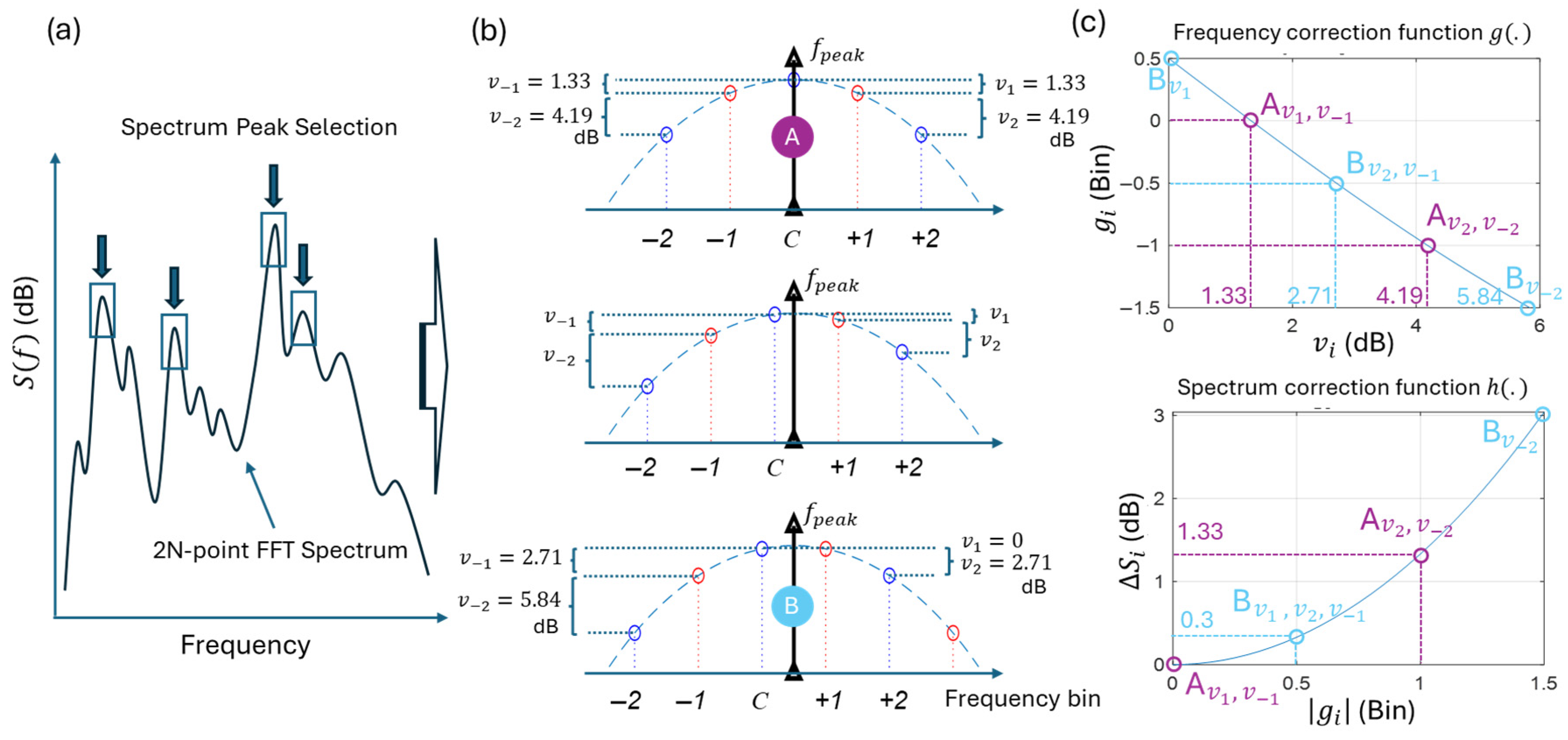

2.1.2. Feature-to-Channel Assignment
2.2. Spectral Event Extraction (SEE) Strategy
2.2.1. Event Generator Block
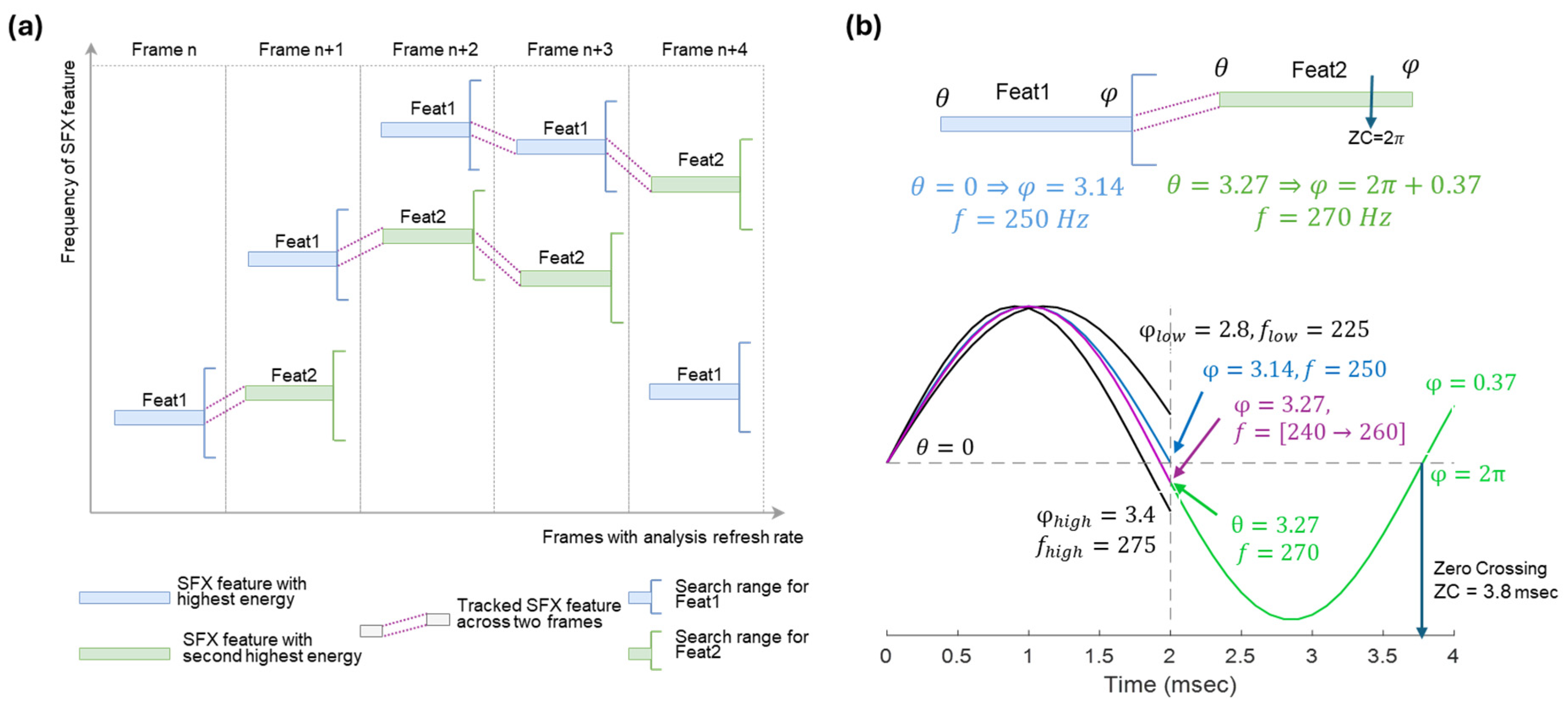
2.2.2. N-of-M Block (Adapted to SEE)
2.3. Numerical Simulation Methods
- A 250 Hz sine wave followed by a complex tone sweep with 3 components (i) from 250 Hz to 1000 Hz, (ii) from 750 Hz to 5000 Hz, and (iii) from 945 Hz to 6300 Hz (i.e., 4 semitones higher than the sine sweep in item (ii) to observe improved spectral leakage and band transition in SFE). The overall sound level was set at 70 dB SPL, with relative levels adjusted such that component (ii) was 3 dB lower/higher than component (i)/(iii). This corresponds approximately to sound levels of 67.6, 64.6, and 61.6 dB SPL for these three components.
- An utterance of the word /abε/, to observe how the two strategies represent the harmonics and formants of a vowel sound.
- An utterance of the word /mà/, in Mandarin, as an example of the potential benefits of SFE for tonal languages.
- An extract of a piano interpretation of Beethoven’s Für Elise, to illustrate how SFE may enhance music representation for CI users.
3. Results
3.1. Crystalis vs. SFE Spectrograms: A Pitch Resolution Assessment
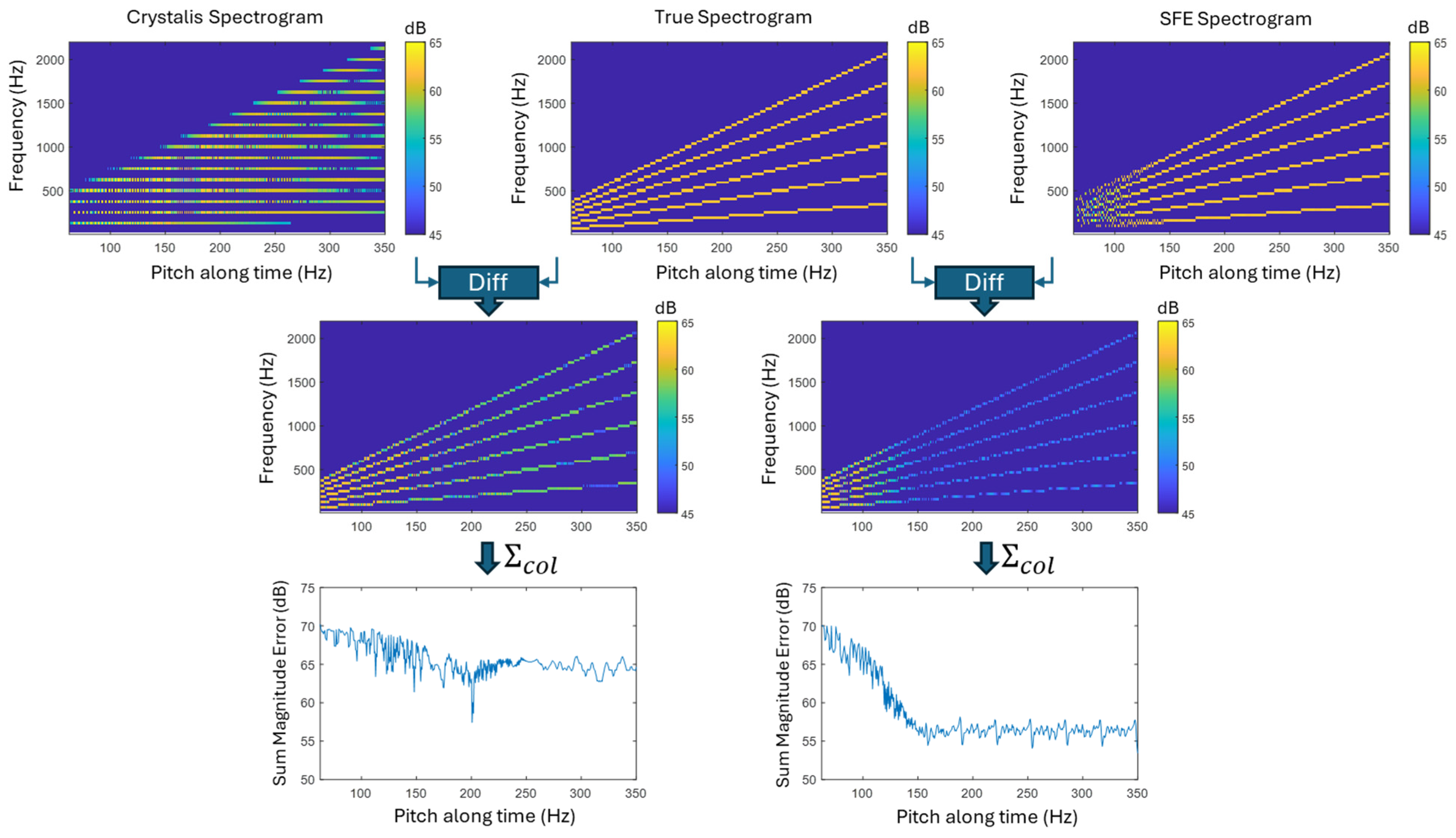
3.2. Crystalis vs. SFE Electrodograms
3.2.1. Synthetic Signals (Sine Sweeps)

3.2.2. Speech
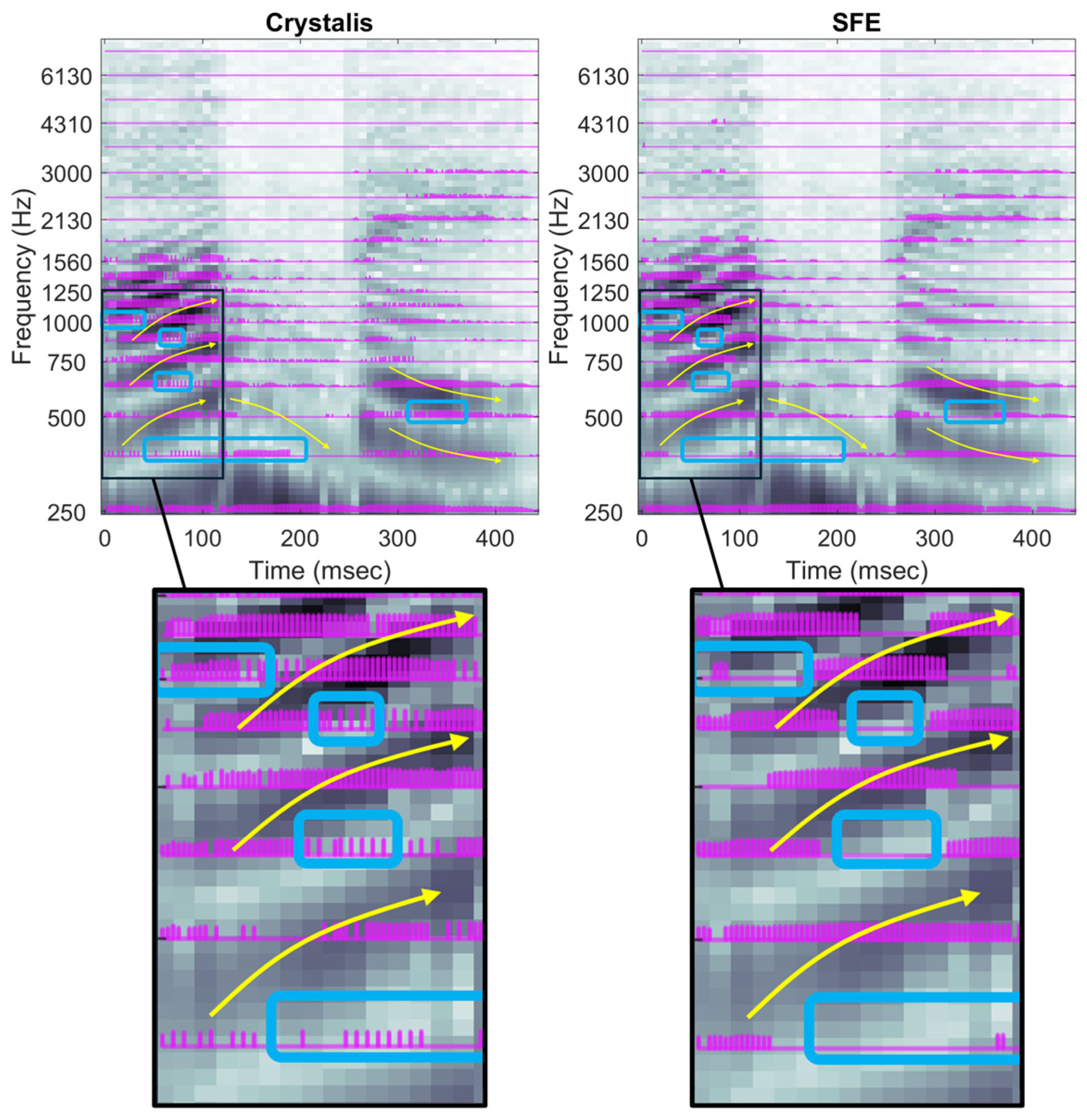
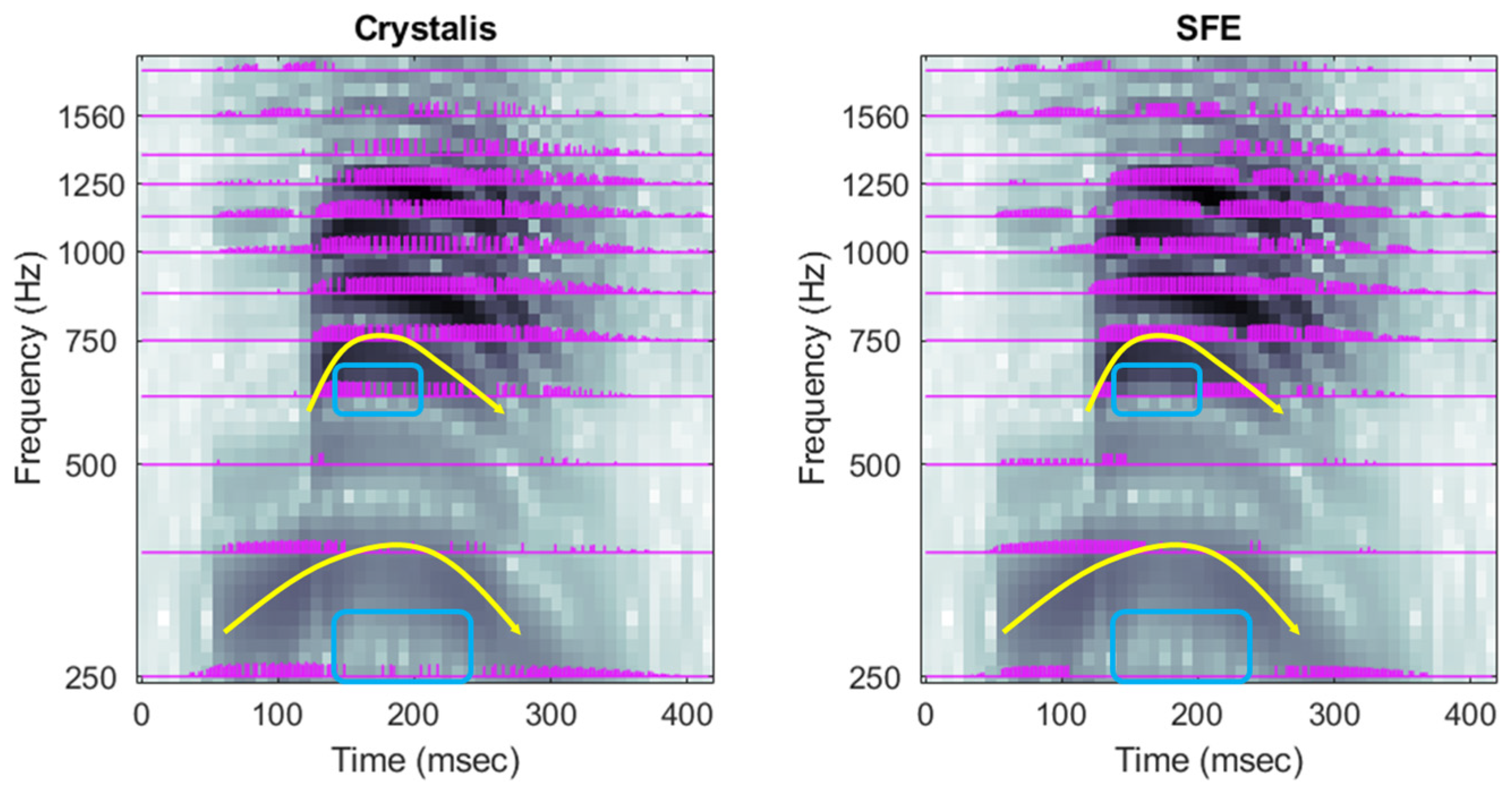
3.2.3. Music
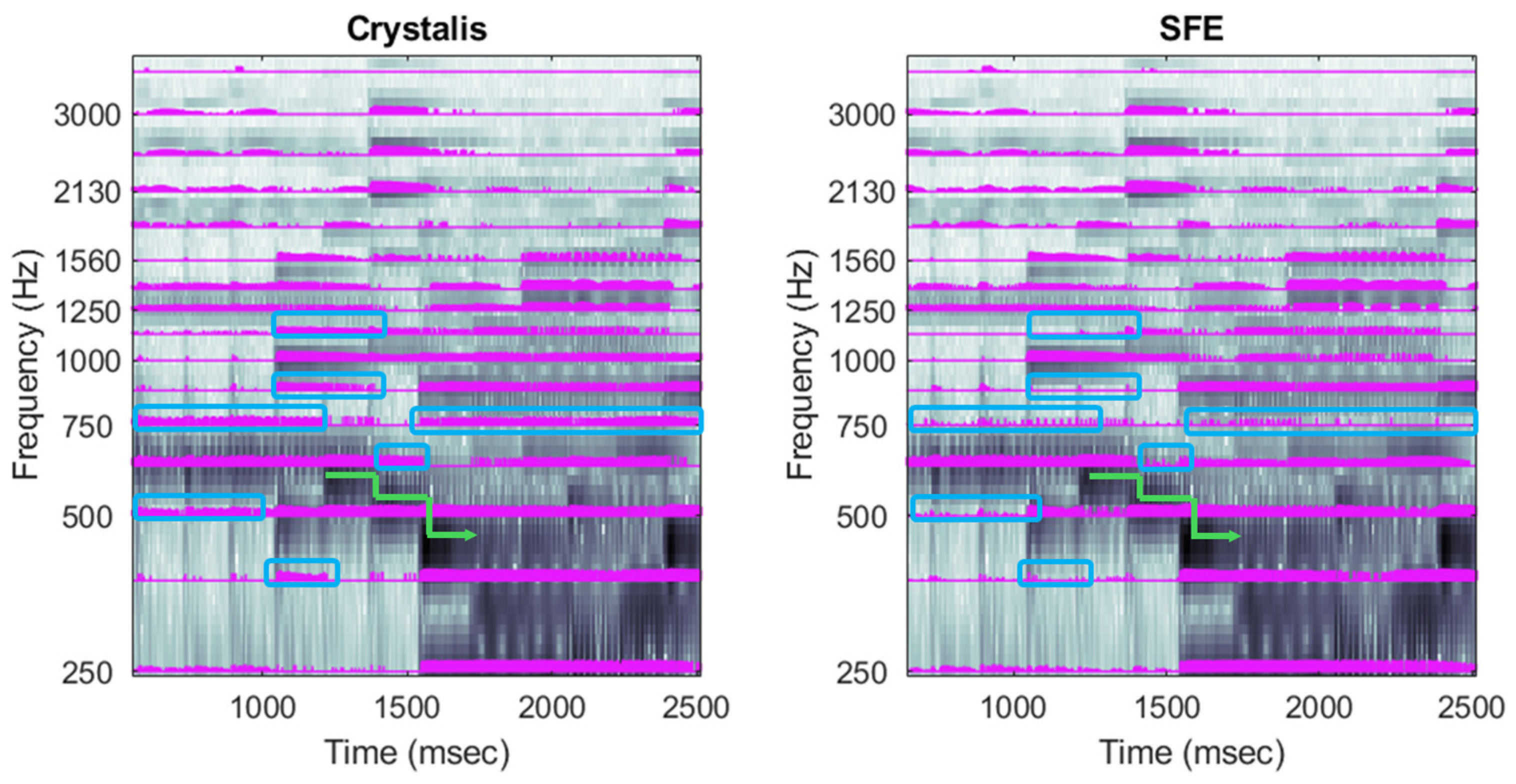
3.3. Feature Tracker

4. Discussion
5. Conclusions
6. Patents
Author Contributions
Funding
Institutional Review Board Statement
Informed Consent Statement
Data Availability Statement
Conflicts of Interest
Abbreviations
| ACE | Advanced Combination Encoder |
| CIS | Continuous Interleaved Sampling |
| F2C | Feature to Channel |
| FAM | Frequency Allocation Map |
| FSM | Frequency Selector Mask |
| FSP | Fine Structure Processing |
| E2C | Event to Channel |
| MUSHRA | Multiple Stimulus with Hidden Reference and Anchor |
| SFE | Spectral Feature Extraction |
| SEE | Spectral Event Extraction |
| SRT | Speech Recognition Threshold |
| TFS | Temporal Fine Structure |
Appendix A
Appendix A.1. Crystalis Strategy: A CIS Variant Strategy

Appendix A.2. Numerical Simulation Parameters

| Frequency Range (Hz) | Electrodes 1 | Knee-Point dB SPL | Knee-Point (C-T)% | Low/Hi IDR dB SPL | T/C-Level µs |
|---|---|---|---|---|---|
| 187.5–1437.5 | E20–E12 | 61 | 70% | 23/95 | 10/80 |
| 1437.5–3437.5 | E11–E6 | 57 | 70% | 23/95 | 10/80 |
| 3437.5–7937.5 | E5–E1 | 50 | 70% | 23/95 | 10/80 |
References
- Wilson, B.S.; Finley, C.C.; Lawson, D.T.; Wolford, R.D.; Zerbi, M. Design and Evaluation of a Continuous Interleaved Sampling (CIS) Processing Strategy for Multichannel Cochlear Implants. J. Rehabil. Res. Dev. 1993, 30, 110–116. [Google Scholar] [PubMed]
- Wilson, B.S.; Finley, C.C.; Lawson, D.T.; Wolford, R.D.; Eddington, D.K.; Rabinowitz, W.M. Better Speech Recognition with Cochlear Implants. Nature 1991, 352, 236–238. [Google Scholar] [CrossRef] [PubMed]
- Carlyon, R.P.; Goehring, T. Cochlear Implant Research and Development in the Twenty-First Century: A Critical Update. J. Assoc. Res. Otolaryngol. 2021, 22, 481–508. [Google Scholar] [CrossRef] [PubMed]
- Henry, F.; Glavin, M.; Jones, E. Noise Reduction in Cochlear Implant Signal Processing: A Review and Recent Developments. IEEE Rev. Biomed. Eng. 2023, 16, 319–331. [Google Scholar] [CrossRef] [PubMed]
- Goupell, M.J. Pushing the Envelope of Auditory Research with Cochlear Implants. Acoust. Today 2015, 11, 26–33. [Google Scholar]
- McDermott, H.J. Music Perception with Cochlear Implants: A Review. Trends Amplif. 2004, 8, 49–82. [Google Scholar] [CrossRef] [PubMed]
- Landsberger, D.M.; Svrakic, M.; Roland, J.T.; Svirsky, M. The Relationship Between Insertion Angles, Default Frequency Allocations, and Spiral Ganglion Place Pitch in Cochlear Implants. Ear Hear. 2015, 36, e207–e213. [Google Scholar] [CrossRef] [PubMed]
- Jiam, N.T.; Gilbert, M.; Cooke, D.; Jiradejvong, P.; Barrett, K.; Caldwell, M.; Limb, C.J. Association Between Flat-Panel Computed Tomographic Imaging–Guided Place-Pitch Mapping and Speech and Pitch Perception in Cochlear Implant Users. JAMA Otolaryngol.-Head Neck Surg. 2019, 145, 109–116. [Google Scholar] [CrossRef] [PubMed]
- Kan, A.; Stoelb, C.; Litovsky, R.Y.; Goupell, M.J. Effect of Mismatched Place-of-Stimulation on Binaural Fusion and Lateralization in Bilateral Cochlear-Implant Users. J. Acoust. Soc. Am. 2013, 134, 2923–2936. [Google Scholar] [CrossRef] [PubMed]
- Nogueira, W.; Nagathil, A.; Martin, R. Making Music More Accessible for Cochlear Implant Listeners: Recent Developments. IEEE Signal Process. Mag. 2019, 36, 115–127. [Google Scholar] [CrossRef]
- Geurts, L.; Wouters, J. Better Place-Coding of the Fundamental Frequency in Cochlear Implants. J. Acoust. Soc. Am. 2004, 115, 844–852. [Google Scholar] [CrossRef] [PubMed]
- Fourakis, M.S.; Hawks, J.W.; Holden, L.K.; Skinner, M.W.; Holden, T.A. Effect of Frequency Boundary Assignment on Vowel Recognition with the Nucleus 24 ACE Speech Coding Strategy. J. Am. Acad. Audiol. 2004, 15, 281–299. [Google Scholar] [CrossRef] [PubMed]
- McKay, C.M.; Henshall, K.R. Frequency-to-Electrode Allocation and Speech Perception with Cochlear Implants. J. Acoust. Soc. Am. 2002, 111, 1036–1044. [Google Scholar] [CrossRef] [PubMed]
- Tabibi, S.; Kegel, A.; Lai, W.K.; Dillier, N. Investigating the Use of a Gammatone Filterbank for a Cochlear Implant Coding Strategy. J. Neurosci. Methods 2017, 277, 63–74. [Google Scholar] [CrossRef] [PubMed]
- Kasturi, K.; Loizou, P.C. Effect of Filter Spacing on Melody Recognition: Acoustic and Electric Hearing. J. Acoust. Soc. Am. 2007, 122, EL29–EL34. [Google Scholar] [CrossRef] [PubMed]
- Omran, S.A.; Lai, W.; Büchler, M.; Dillier, N. Semitone Frequency Mapping to Improve Music Representation for Nucleus Cochlear Implants. EURASIP J. Audio Speech Music Process. 2011, 2011, 2. [Google Scholar] [CrossRef]
- Goehring, T.; Archer-Boyd, A.W.; Arenberg, J.G.; Carlyon, R.P. The Effect of Increased Channel Interaction on Speech Perception with Cochlear Implants. Sci. Rep. 2021, 11, 10383. [Google Scholar] [CrossRef] [PubMed]
- Nogueira, W.; Rode, T.; Büchner, A. Spectral Contrast Enhancement Improves Speech Intelligibility in Noise for Cochlear Implants. J. Acoust. Soc. Am. 2016, 139, 728–739. [Google Scholar] [CrossRef] [PubMed]
- Nogueira, W.; Litvak, L.; Edler, B.; Ostermann, J.; Büchner, A. Signal Processing Strategies for Cochlear Implants Using Current Steering. EURASIP J. Adv. Signal Process. 2009, 2009, 531213. [Google Scholar] [CrossRef]
- Nogueira, W.; Kátai, A.; Harczos, T.; Klefenz, F.; Buechner, A.; Edler, B. An Auditory Model Based Strategy for Cochlear Implants. In Proceedings of the Annual International Conference of the IEEE Engineering in Medicine and Biology-Proceedings, Lyon, France, 22–26 August 2007; pp. 4127–4130. [Google Scholar]
- Stahl, P.; Dang, K.; Vandersteen, C.; Guevara, N.; Clerc, M.; Gnansia, D. Current Distribution of Distributed All-Polar Cochlear Implant Stimulation Mode Measured in-Situ. PLoS ONE 2022, 17, e0275961. [Google Scholar] [CrossRef] [PubMed]
- Lee, S.Y.; Kim, Y.S.; Jo, H.D.; Kim, Y.; Carandang, M.; Huh, G.; Choi, B.Y. Effects of in vivo Repositioning of Slim Modiolar Electrodes on Electrical Thresholds and Speech Perception. Sci. Rep. 2021, 11, 15135. [Google Scholar] [CrossRef] [PubMed]
- Moore, B.C.J. Coding of Sounds in the Auditory System and Its Relevance to Signal Processing and Coding in Cochlear Implants. Otol. Neurotol. 2003, 24, 243–254. [Google Scholar] [CrossRef] [PubMed]
- Li, X.; Nie, K.; Atlas, L.; Rubinstein, J. Harmonic Coherent Demodulation for Improving Sound Coding in Cochlear Implants. In Proceedings of the ICASSP, IEEE International Conference on Acoustics, Speech and Signal Processing, Dallas, TX, USA, 14–19 March 2010; Proceedings. Institute of Electrical and Electronics Engineers Inc.: New York, NY, USA, 2010; pp. 5462–5465. [Google Scholar]
- Zhou, H.; Kan, A.; Yu, G.; Guo, Z.; Zheng, N.; Meng, Q. Pitch Perception with the Temporal Limits Encoder for Cochlear Implants. IEEE Trans. Neural Syst. Rehabil. Eng. 2022, 30, 2528–2539. [Google Scholar] [CrossRef] [PubMed]
- Zierhofer, C.; Schatzer, R. A Fine Structure Stimulation Strategy and Related Concepts. In Cochlear Implant Research Updates; IntechOpen: London, UK, 2012. [Google Scholar]
- Riss, D.; Hamzavi, J.-S.; Selberherr, A.; Kaider, A.; Blineder, M.; Starlinger, V.; Gstoettner, W.; Arnoldner, C. Envelope versus Fine Structure Speech Coding Strategy: A Crossover Study. Otol. Neurotol. 2011, 32, 1094–1101. [Google Scholar] [CrossRef] [PubMed]
- Magnusson, L. Comparison of the Fine Structure Processing (FSP) Strategy and the CIS Strategy Used in the MED-EL Cochlear Implant System: Speech Intelligibility and Music Sound Quality. Int. J. Audiol. 2011, 50, 279–287. [Google Scholar] [CrossRef] [PubMed]
- Riss, D.; Hamzavi, J.-S.; Blineder, M.; Flak, S.; Baumgartner, W.-D.; Kaider, A.; Arnoldner, C. Effects of Stimulation Rate with the FS4 and HDCIS Coding Strategies in Cochlear Implant Recipients. Otol. Neurotol. 2016, 37, 882–888. [Google Scholar] [CrossRef] [PubMed]
- Müller, J.; Brill, S.; Hagen, R.; Moeltner, A.; Brockmeier, S.J.; Stark, T.; Helbig, S.; Maurer, J.; Zahnert, T.; Zierhofer, C.; et al. Clinical Trial Results with the Med-El Fine Structure Processing Coding Strategy in Experienced Cochlear Implant Users. ORL 2012, 74, 185–198. [Google Scholar] [CrossRef] [PubMed]
- Zhang, Y.; Johannesen, P.T.; Molaee-Ardekani, B.; Wijetillake, A.; Attili Chiea, R.; Hasan, P.Y.; Segovia-Martínez, M.; Lopez-Poveda, E.A. Comparison of Performance for Cochlear-Implant Listeners Using Audio Processing Strategies Based on Short-Time Fast Fourier Transform or Spectral Feature Extraction. Ear Hear. 2024, 46, 163–183. [Google Scholar] [CrossRef] [PubMed]
- Bergeron, F.; Hotton, M. Perception in Noise with the Digisonic SP Cochlear Implant: Clinical Trial of Saphyr Processor’s Upgraded Signal Processing. Eur. Ann. Otorhinolaryngol. Head. Neck Dis. 2016, 133, S4–S6. [Google Scholar] [CrossRef] [PubMed]
- Langner, F.; Büchner, A.; Nogueira, W. Evaluation of an Adaptive Dynamic Compensation System in Cochlear Implant Listeners. Trends Hear. 2020, 24. [Google Scholar] [CrossRef] [PubMed]
- Oppenheim, A.V.; Schafer, R.W. Discrete-Time Signal Processing (Prentice-Hall Signal Processing Series), 3rd ed.; Pearson: Bloomington, MN, USA, 2009. [Google Scholar]
- Saadoun, A.; Schein, A.; Péan, V.; Legrand, P.; Aho Glélé, L.S.; Grayeli, A.B. Frequency Fitting Optimization Using Evolutionary Algorithm in Cochlear Implant Users with Bimodal Binaural Hearing. Brain Sci. 2022, 12, 253. [Google Scholar] [CrossRef] [PubMed]
- Creff, G.; Lambert, C.; Coudert, P.; Pean, V.; Laurent, S.; Godey, B. Comparison of Tonotopic and Default Frequency Fitting for Speech Understanding in Noise in New Cochlear Implantees: A Prospective, Randomized, Double-Blind, Cross-Over Study. Ear Hear. 2024, 45, 35–52. [Google Scholar] [CrossRef] [PubMed]
- Lassaletta, L.; Calvino, M.; Sánchez-Cuadrado, I.; Gavilán, J. Does It Make Any Sense to Fit Cochlear Implants According to the Anatomy-Based Fitting? Our Experience with the First Series of Patients. Front. Audiol. Otol. 2023, 1, 1298538. [Google Scholar] [CrossRef]
- Riss, D.; Hamzavi, J.S.; Blineder, M.; Honeder, C.; Ehrenreich, I.; Kaider, A.; Baumgartner, W.D.; Gstoettner, W.; Arnoldner, C. FS4, FS4-p, and FSP: A 4-Month Crossover Study of 3 Fine Structure Sound-Coding Strategies. Ear Hear. 2014, 35, e272–e281. [Google Scholar] [CrossRef] [PubMed]
- Firszt, J.B.; Holden, L.K.; Reeder, R.M.; Skinner, M.W. Speech Recognition in Cochlear Implant Recipients: Comparison of Standard HiRes and HiRes 120 Sound Processing. Otol. Neurotol. 2009, 30, 146–152. [Google Scholar] [CrossRef] [PubMed]
- Tahmasebi, S.; Segovia-Martinez, M.; Nogueira, W. Optimization of Sound Coding Strategies to Make Singing Music More Accessible for Cochlear Implant Users. Trends Hear. 2023, 27, 23312165221148022. [Google Scholar] [CrossRef] [PubMed]
- Hillenbrand, J.M.; Clark, M.J.; Nearey, T.M. Effects of Consonant Environment on Vowel Formant Patterns. J. Acoust. Soc. Am. 2001, 109, 748–763. [Google Scholar] [CrossRef] [PubMed]
- Bleckly, F.; Lo, C.Y.; Rapport, F.; Clay-Williams, R. Music Perception, Appreciation, and Participation in Postlingually Deafened Adults and Cochlear Implant Users: A Systematic Literature Review. Trends Hear. 2024, 28, 23312165241287391. [Google Scholar] [CrossRef] [PubMed]
- Liu, H.; Peng, X.; Zhao, Y.; Ni, X. The Effectiveness of Sound-Processing Strategies on Tonal Language Cochlear Implant Users: A Systematic Review. Pediatr. Investig. 2017, 1, 32–39. [Google Scholar] [CrossRef] [PubMed]
- Di Maro, F.; Carner, M.; Sacchetto, A.; Soloperto, D.; Marchioni, D. Frequency Reallocation Based on Cochlear Place Frequencies in Cochlear Implants: A Pilot Study. Eur. Arch. Oto-Rhino-Laryngol. 2022, 279, 4719–4725. [Google Scholar] [CrossRef] [PubMed]
- Roy, A.T.; Carver, C.; Jiradejvong, P.; Limb, C.J. Musical Sound Quality in Cochlear Implant Users: A Comparison in Bass Frequency Perception between Fine Structure Processing and High-Definition Continuous Interleaved Sampling Strategies. Ear Hear. 2015, 36, 582–590. [Google Scholar] [CrossRef] [PubMed]
- Gfeller, K.; Oleson, J.; Knutson, J.F.; Breheny, P.; Driscoll, V.; Olszewski, C. Multivariate Predictors of Music Perception and Appraisal by Adult Cochlear Implant Users. J. Am. Acad. Audiol. 2008, 19, 120–134. [Google Scholar] [CrossRef] [PubMed]
- Xu, Y.; Sun, X. Maximum Speed of Pitch Change and How It May Relate to Speech. J. Acoust. Soc. Am. 2002, 111, 1399–1413. [Google Scholar] [CrossRef] [PubMed]
- Zeng, F. Trends in Cochlear Implants. Trends Amplif. 2004, 8, 1–34. [Google Scholar] [CrossRef] [PubMed]
- Kiefer, J.; Hohl, S.; Stürzebecher, E.; Pfennigdorff, T.; Gstöettner, W. Comparison of Speech Recognition with Different Speech Coding Strategies (SPEAK, CIS, and ACE) and Their Relationship to Telemetric Measures of Compound Action Potentials in the Nucleus CI 24M Cochlear Implant System. Audiology 2001, 40, 32–42. [Google Scholar] [CrossRef] [PubMed]

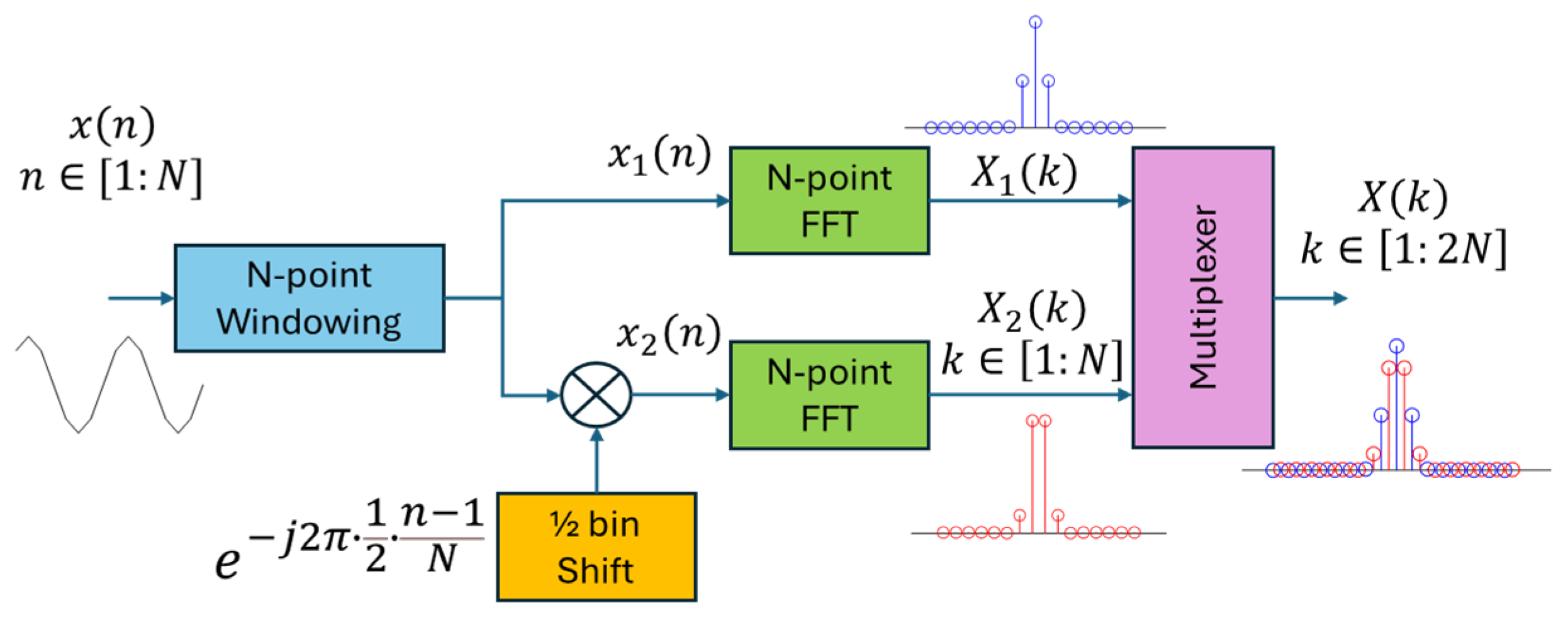



Disclaimer/Publisher’s Note: The statements, opinions and data contained in all publications are solely those of the individual author(s) and contributor(s) and not of MDPI and/or the editor(s). MDPI and/or the editor(s) disclaim responsibility for any injury to people or property resulting from any ideas, methods, instructions or products referred to in the content. |
© 2025 by the authors. Licensee MDPI, Basel, Switzerland. This article is an open access article distributed under the terms and conditions of the Creative Commons Attribution (CC BY) license (https://creativecommons.org/licenses/by/4.0/).
Share and Cite
Molaee-Ardekani, B.; Attili Chiea, R.; Zhang, Y.; Felding, J.; Wijetillake, A.A.; Johannesen, P.T.; Lopez-Poveda, E.A.; Segovia-Martínez, M. A Novel Sound Coding Strategy for Cochlear Implants Based on Spectral Feature and Temporal Event Extraction. Technologies 2025, 13, 318. https://doi.org/10.3390/technologies13080318
Molaee-Ardekani B, Attili Chiea R, Zhang Y, Felding J, Wijetillake AA, Johannesen PT, Lopez-Poveda EA, Segovia-Martínez M. A Novel Sound Coding Strategy for Cochlear Implants Based on Spectral Feature and Temporal Event Extraction. Technologies. 2025; 13(8):318. https://doi.org/10.3390/technologies13080318
Chicago/Turabian StyleMolaee-Ardekani, Behnam, Rafael Attili Chiea, Yue Zhang, Julian Felding, Aswin Adris Wijetillake, Peter T. Johannesen, Enrique A. Lopez-Poveda, and Manuel Segovia-Martínez. 2025. "A Novel Sound Coding Strategy for Cochlear Implants Based on Spectral Feature and Temporal Event Extraction" Technologies 13, no. 8: 318. https://doi.org/10.3390/technologies13080318
APA StyleMolaee-Ardekani, B., Attili Chiea, R., Zhang, Y., Felding, J., Wijetillake, A. A., Johannesen, P. T., Lopez-Poveda, E. A., & Segovia-Martínez, M. (2025). A Novel Sound Coding Strategy for Cochlear Implants Based on Spectral Feature and Temporal Event Extraction. Technologies, 13(8), 318. https://doi.org/10.3390/technologies13080318






